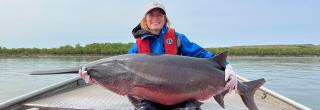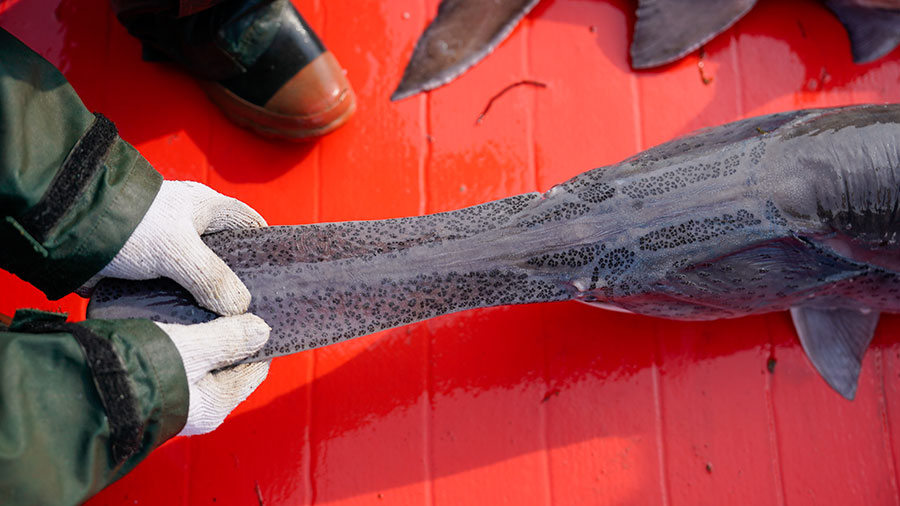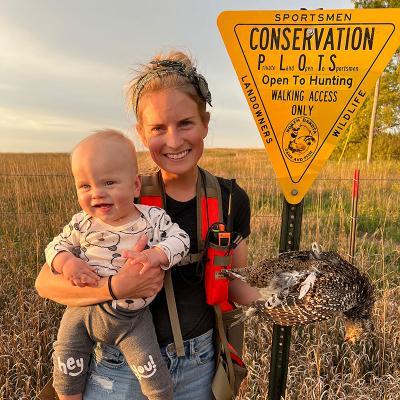
Paddlefish Tagging
We often tout we’re one of the smallest state wildlife agencies in the country, while remaining in the top five per capita for hunting and fishing participation. Sure, we’d love to have more staff and resources but we’re proud of what we’re able to accomplish as is. And there are certainly benefits to being so small. We’re nimble, everybody knows everybody, and as a growing professional, there’s always opportunities to gain experiences across the agency.
Especially during field season.
Living on the Northern Plains, the days to count fish, muscle in concrete boat ramps with heavy equipment, and plant grass are numbered, but rest assured our staff is making the most of the time allowed.
It was on one of those such days I was graciously (or perhaps maliciously) invited to join a fisheries crew on the Missouri River to net and tag paddlefish.
I once again took a quick trip to the girl’s room and came back to eat my strawberries and sandwich. I recall shoving in the last few bites to join the rest of the crew in applying sunscreen before shoving off from our 11-minute lunch break.
We cruised back north to what they deemed the “Honey Hole” to ensure I hold a fish larger than me at least once. And the Honey Hole held true to its name when the first fish we wrangled into the boat (not by me) weighed in at 110 pounds. If I’m being honest, the prehistoric fish was a few pounds shy of my current weight, but nonetheless impressive, and just about knocked me over when the guys put it on my lap.
Of course, I failed to mention “the speech” Paul was encouraged to give me after we caught our first fish of the day, one I suspect he doesn’t mind giving.
The gist of it is this: paddlefish feed on zooplankton, tiny organisms floating around in the water. Their rostrums act as giant zooplankton locating wands. They’re covered in sensors called ampullae of Lorenzini, that detect the plankton in the water column.

We have two populations of paddlefish in North Dakota, the population north of Garrison Dam that live in Lake Sakakawea and the confluence of the Yellowstone and Missouri rivers that has a snagging season, and the one we’re sampling today. This population exists south of the Garrison Dam to Oahe Dam in South Dakota. These fish head north to the area we were patrolling with nets to spawn, though it’s believed the river has been modified too much for them to be successful in reproducing. Based on annual Department tagging studies, it’s estimated there are roughly 10,000-12,000 paddlefish in the stretch of the river north of Bismarck that time of year. Considering paddlefish only attempt to spawn every 2-3 years, fisheries biologists estimate their population is about double that. Although it’s likely after those few weeks they reverse course and head south and disperse into Lake Oahe.
Currently, biologists don’t believe there is a sustainably harvestable population, but boy was it surprising how many paddlefish we lugged out of the river that day.
After a slower afternoon, we end the day at 169 paddlefish caught. Roughly about half of which had been previously tagged by the Department and half of which we tagged that day. I feel guilty about how hard those guys worked and how little I contributed, holding steady to my role of tightening the net, lifting fish less than 50 pounds, and offering some comedic relief.
When we pulled back into the shop on that beautiful Friday afternoon, there were several trucks still in the parking lot that were there before me, likely belonging to fisheries development and wildlife employees.
May was a busy month on my end, and I know it’s always one of the busiest for our field staff. As I hosed off my rainsuit back at home, I felt nothing but gratitude for somehow sliding my way into a job that offers many interesting and rewarding opportunities. But even greater was the feeling of pride for the Department. I can confidently say, not a penny of our sportsmen’s dollars is wasted after viewing the work ethic, efficiency, knowledge, creativity and passion aboard that boat.
Although I would propose we spend a few pennies next time on some smaller gloves.



